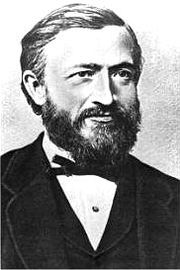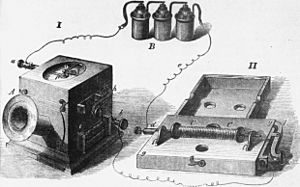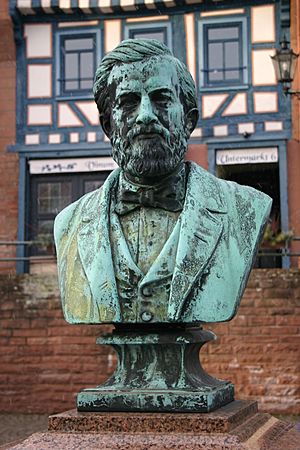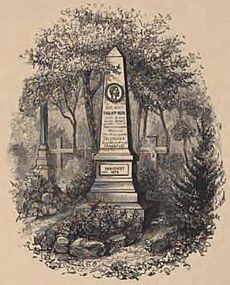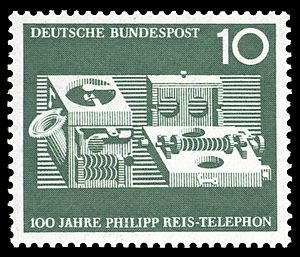Johann Philipp Reis facts for kids
Johann Philipp Reis (born January 7, 1834 – died January 14, 1874) was a German scientist and inventor who taught himself many things. In 1861, he built the very first "make-and-break" telephone. Today, this invention is known as the Reis telephone.
Contents
Early Life and Learning
Reis was born in Gelnhausen, Germany. His father was a master baker. Sadly, Reis's mother passed away when he was a baby. His grandmother, who was very smart and well-read, raised him.
When he was six, Reis went to school in Gelnhausen. His teachers noticed how talented he was and suggested his father send him to a better college. But his father died before Reis turned ten. His grandmother and guardians then sent him to Garnier's Institute in Friedrichsdorf. There, he loved learning languages like French and English. He also read many books from the library.
At 14, Reis went to the Hassel Institute in Frankfurt. He learned Latin and Italian there. He also developed a strong love for science. His guardians were told to send him to the Polytechnic School in Karlsruhe. However, his uncle wanted him to become a merchant. So, in 1850, Reis unwillingly started an apprenticeship as a paints dealer in Frankfurt. He told his uncle he would learn the business but would continue his studies whenever he could.
Reis worked hard and earned the respect of his employer. In his free time, he studied on his own. He took private lessons in mathematics and physics. He also attended lectures on mechanics. After his apprenticeship, Reis went to Dr. Poppe's Institute in Frankfurt. Since history and geography weren't taught there, some students, including Reis, decided to teach each other. Reis taught geography and felt that teaching was his true calling. He also joined the Physical Society of Frankfurt.
In 1855, he finished his year of military service. Then he returned to Frankfurt to become a teacher of mathematics and science. He planned to finish his training at the University of Heidelberg. But in 1858, he visited his old friend, Hofrath Garnier, who offered him a teaching job at Garnier's Institute.
On September 14, 1859, Reis got married. Soon after, he moved to Friedrichsdorf to start his new life as a teacher.
Inventing the Telephone
Reis had an idea that electricity could travel through space, like light, without needing a wire. He did some experiments on this. He wrote about his findings in a paper called "On the Radiation of Electricity." In 1859, he sent it to Professor Poggendorff for a famous science magazine. But the magazine rejected his paper, which made the young teacher very sad.
Reis, like Alexander Graham Bell later, had studied the human ear. For years, he had thought about building a machine to send sound using electricity. Inspired by his physics lessons, he worked on this problem and found success. In 1860, he built the first version of a telephone. It could send sounds over 100 meters (about 328 feet). In 1862, he tried again to interest Professor Poggendorff with a description of his "telephon," as he called it. His second attempt was also rejected. The professor seemed to think sending speech by electricity was impossible. Reis sadly believed the failure was because he was "only a poor schoolmaster."
Reis found it hard to get people in Germany interested in his invention. Even after showing it to important people like Wilhelm von Legat, an inspector for the Royal Prussian Telegraph Corps, in 1862, it didn't get much attention. However, it gained more interest in the United States in 1872 when Professor Vanderwyde showed it in New York.
Before 1947, a British company called Standard Telephones and Cables (STC) tested Reis's device. The tests showed it could faintly send and receive speech. At that time, STC was trying to get a contract with Alexander Graham Bell's company. So, STC's chairman, Sir Frank Gill, kept the test results a secret to protect Bell's reputation.
Earlier Ideas for Transmitting Sound
After the telephone was invented, people remembered that in 1854, a French telegraph worker named M. Charles Bourseul had thought of a way to send sounds and even speech using electricity. He wrote:
Imagine a person speaking near a flexible disc that vibrates with the voice. This disc then makes and breaks an electric current. At a distance, another disc could vibrate in the same way. ...It is certain that, in the future, speech will be sent by electricity. I have experimented with this; it is difficult and needs time and patience, but the results so far look promising.
Bourseul deserves credit for being one of the first to think of an electric telephone. But Reis deserves the honor of being the first to actually build a device that could send and receive sounds electrically.
Bourseul's idea didn't get much notice and was soon forgotten. It's very unlikely Reis ever heard of it. Reis came up with a similar device by studying the human ear. He knew the ear had a membrane that vibrated from sound waves. These vibrations were then sent to the auditory nerve. So, he thought if he made a diaphragm (a thin sheet) to act like this membrane, and it vibrated to make and break an electric circuit, he could use the electricity to reproduce the original sounds far away.
In 1837-38, Professor Page of Massachusetts found that an iron needle inside a coil of wire would make a quiet 'tick' each time an electric current in the coil was interrupted. If these ticks happened fast enough, they would blend into a continuous hum, which he called "galvanic music." He also found that the sound's pitch changed with how fast the current was interrupted. These faint sounds were caused by magnetostriction, which is when a material changes shape slightly when it's magnetized. From these and other discoveries, Reis knew that if the current interrupted by his vibrating diaphragm was sent through wires to a distant coil, the iron needle would make sounds similar to those that caused the diaphragm to vibrate. Using this knowledge, he built his first telephone. Reis's original device is now in a museum in Berlin.
Challenges with Reis's Telephone
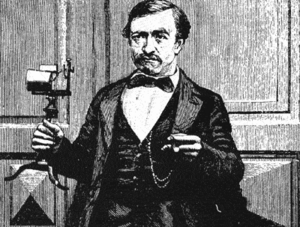
One of Reis's early transmitters looked like a rough model of a human ear, carved from oak. It had a drum that moved a small platinum lever. This lever would open and close a contact point in the electric circuit. He made about ten or twelve different versions, each better than the last. They could transmit music quite well, and even a word or two of speech, though not perfectly.
Later, the invention of the microphone helped explain why Reis's telephone had trouble with speech. Reis's transmitter worked by interrupting the electric current completely. The spring was supposed to close the contact after a vibration opened it. This worked well for musical tones because they are regular, repeating vibrations. However, speech vibrations are irregular and complex. To transmit speech clearly, the electric current needs to change in strength without being completely broken. The sound waves from a voice should create matching waves in the electric current. In simple terms, the current should "ripple" along with the air's vibrations. Reis's phone was not good at sending clear speech, but it could send the pitch of a sound.
A report from Herr von Legat, a Prussian Telegraphs inspector, published in 1862, shows that Reis understood this idea. But his instrument wasn't designed to apply it well. His platinum contacts likely acted a bit like a simple microphone. This is why a few words, especially familiar ones, could sometimes be heard at the other end. If Reis's phone was adjusted so the contacts were just barely touching, it would work more like later telephones. So, the Reis phone worked best for speech when it was slightly out of its intended adjustment.
A history book from 1910 mentions that a Reis machine was brought to court during a lawsuit. It made squeaking noises but couldn't speak clearly. Experts tried to make it work, but it wouldn't transmit a single understandable sentence. One lawyer joked, "It can speak, but it won't." We now know that while a Reis machine might transmit a word or two imperfectly if it was not working as intended, it was built on the wrong idea for clear speech.
Judge Lowell, in a famous court decision, said:
A hundred years of Reis would never have created a speaking telephone just by improving its construction. It was Bell who discovered that the problem was not with how it was built, but with the main idea it was based on. …Bell discovered a new way—that of sending speech by electricity, and his invention is even bigger than his claim. …To follow Reis is to fail; but to follow Bell is to succeed.
Reis didn't seem to fully understand the importance of not completely breaking the electric circuit. His metal spring allowed the contacts to jump too far apart, which stopped the electric current.
He did his experiments in a small workshop behind his home in Friedrichsdorf. Wires ran from it to an upstairs room. Another line was set up between the science room at Garnier's Institute and a classroom across the playground. There was a story in the school that the boys were afraid to make too much noise in the classroom because Philipp Reis might hear them with his "telephon."
Sharing the Invention
Reis presented his new invention in a lecture to the Physical Society of Frankfurt on October 26, 1861. He also wrote a description for a yearly report a month or two later. His invention caused a lot of scientific excitement in Germany. Models of it were sent to London, Dublin, and other places. It became a topic for popular lectures and a display in science cabinets.
Reis became famous for a short time, but then his invention was rejected. The Physical Society of Frankfurt, which had gained fame from his device, turned its back on it. Reis resigned from the society in 1867. The Free German Institute of Frankfurt, which had made him an honorary member, also dismissed his instrument as just a "philosophical toy."
Reis believed in his invention, even if others didn't. If he had been encouraged from the start, he might have made it perfect. However, he was already sick with tuberculosis. After Reis gave a lecture about the telephone in Gießen in 1854, Professor Poggendorff, who was there, invited him to send a description of his instrument to his magazine. Reis reportedly replied: "Thank you very much, Professor, but it is too late. Now I do not want to send it. My apparatus will become known without any description in the Annalen."
Final Years
Later, Reis continued teaching and his scientific studies. But his worsening health became a big problem. For several years, he had to use his strong willpower just to keep doing his duties. His voice began to fail as his lung disease got worse. In the summer of 1873, he had to stop teaching for several weeks. An autumn vacation gave him hope of getting better, and he went back to teaching. But this was the last burst of his fading life. It was announced that he would show his new gravity machine at a meeting in Wiesbaden in September, but he was too ill to attend. In December, he became bedridden. After a long and painful illness, he died at five o'clock in the afternoon on January 14, 1874.
In his life story, he wrote:
As I look back upon my life I can truly say with the Holy Scriptures that it has been "hard work and sadness." But I also thank the Lord that He has blessed me in my work and with my family, and has given me more good than I ever asked for. The Lord has helped me until now; He will help me even more.
Philipp Reis was buried in the cemetery of Friedrichsdorf. In 1878, after the electric telephone became well-known, the members of the Physical Society of Frankfurt put up a monument of red sandstone with his portrait over his grave.
Recognition and Technology
In 1878, four years after Reis died and two years after Bell received his first telephone patent, European scientists honored Philipp Reis as the inventor of the telephone.
Documents from 1947 in London's Science Museum later showed something interesting. Engineers from the British company Standard Telephones and Cables (STC) tested Reis's telephone from 1863. They found that after some technical adjustments, it could transmit and "reproduce speech of good quality, but not very loudly."
Sir Frank Gill, who was the chairman of STC at the time, ordered these test results to be kept secret. This was because STC was negotiating a contract with AT&T, which had grown from Alexander Graham Bell's company. Professor Bell was generally accepted as the inventor of the telephone. Gill thought that evidence proving otherwise might harm the ongoing negotiations.
Johann-Philipp-Reis Award
The VDE (the German electrical engineering association), Deutsche Telekom, and the cities of Friedrichsdorf and Gelnhausen give out the Johann-Philipp-Reis Preis (prize) every two years. This award honors scientists for "distinguished scientific achievements in communication technology."
See Also
 In Spanish: Johann Philipp Reis para niños
In Spanish: Johann Philipp Reis para niños
- German inventors and discoverers
- History of the telephone


